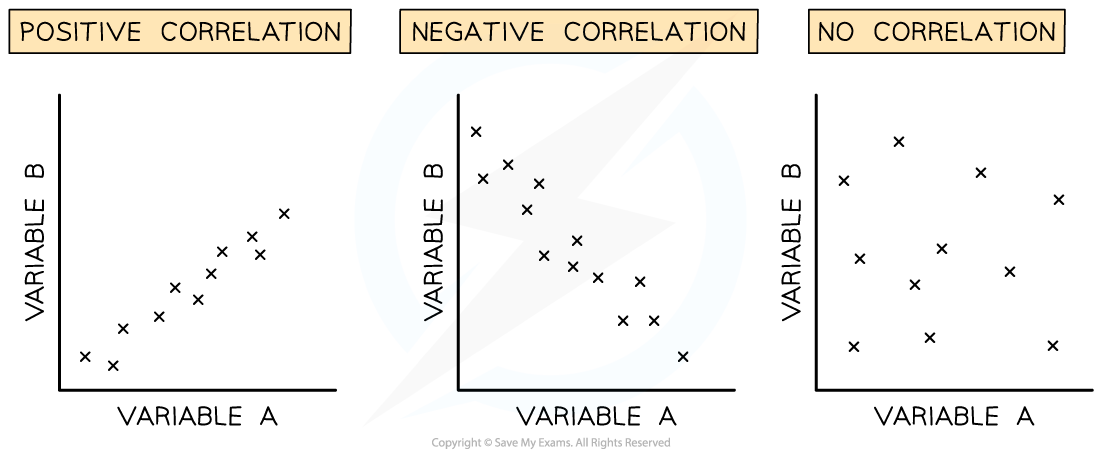Pearson's Linear Correlation (Cambridge (CIE) A Level Biology) : Revision Note
Pearson's Linear Correlation
When recording the abundance and distribution of species in an area different trends may be observed
Sometimes correlation between two variables can appear in the data
Correlation is an association or relationship between variables
There is a clear distinction between correlation and causation: a correlation does not necessarily imply a causative relationship
Causation occurs when one variable has an influence on, or is influenced by, another
There may be a correlation between species; for example, two species always occurring together
There may be a correlation between a species and an abiotic factor, for example, a particular plant species and the soil pH
The apparent correlation between variables can be analysed using scatter graphs and different statistical tests
Correlation between variables
In order to get a broad overview of the correlation between two variables the data points for both variables can be plotted on a scatter graph
The correlation coefficient (r) indicates the strength of the relationship between variables
Perfect correlation occurs when all of the data points lie on a straight line with a correlation coefficient of 1.0 or -1.0
Correlation can be positive or negative
Positive correlation: as variable A increases, variable B increases
Negative correlation: as variable A increases, variable B decreases
If there is no correlation between variables the correlation coefficient will be 0
Types of Correlation Sketch Graphs

Different types of correlation in scatter graphs
The correlation coefficient (r) can be calculated to determine whether a linear relationship exists between variables and how strong that relationship is
Pearson linear correlation
Pearson's linear correlation is a statistical test that determines whether there is linear correlation between two variables
The data must:
Be quantitative, e.g. the number of individuals has been counted and a numerical value recorded
Show a linear relationship upon visual inspection
Show a normal distribution
Method:
Step 1: Create a scatter graph of data gathered and identify if a linear correlation exists
Step 2: State a null hypothesis
Step 3: Use the following equation to work out Pearson’s correlation coefficient r

Where:
r = correlation coefficient
x = number of species A
y = number of species B
n = number of readings
Sx = standard deviation of species A
Sy = standard deviation of species B
x̄= mean number of species A
ȳ= mean number of species B
If the correlation coefficient r is close to 1.0 or -1.0 then it can be stated that there is a strong linear correlation between the two variables and the null hypothesis can be rejected
Worked Example
Some students used quadrats to measure the abundance of different plant species in a garden. They noticed that two particular species seemed to occur alongside each other. They plotted a scatter graph and the data they collected had no major outliers and showed roughly normal distribution.

Scatter graph showing the linear correlation between the abundance of species A and B. It shows linear correlation and so is suitable for analysis by Pearson’s correlation coefficient.
Investigate the possible correlation using Pearson’s linear correlation coefficient.
Null hypothesis: There is no correlation between the abundance of species A and species B.
Steps to calculate the correlation coefficient:
Step 1: Calculate xy
Step 2: Calculate x̅ and y̅ (these are the means of x and y)
Step 3: Calculate nx̅y̅
Step 4: Find ∑xy
Step 5: Calculate standard deviation for each set of data Sx and Sy
Step 6: Substitute the appropriate numbers into the equation

Quadrat | No. of individuals of species A (x) | No. of individuals of species B (x) | xy |
|---|---|---|---|
1 | 10 | 21 | 210 |
2 | 11 | 19 | 209 |
3 | 11 | 22 | 242 |
4 | 6 | 15 | 90 |
5 | 8 | 16 | 128 |
6 | 14 | 24 | 336 |
7 | 10 | 19 | 190 |
8 | 12 | 24 | 288 |
9 | 11 | 21 | 231 |
10 | 10 | 19 | 190 |
Mean | x̄ = 10.3 | ȳ = 20 | ∑xy = 2114 |
nx̄ȳ | 10 × 10.3 × 20 = 2060 |
| |
Standard deviation | Sx = 2.16 | Sy = 3.02 |
|
n = 10 as there are 10 quadrat samples
The sum of x x y (∑xy) = 2114
n x mean of x x mean of y = nx̅y̅ = 2060
Sx = 2.16 and Sy = 3.02
Substitute values into the equation above:
As the value of r lies close to 1, the null hypothesis can be rejected
There is a strong positive correlation between the abundance of species A and species B
Examiner Tips and Tricks
You will be provided with the formula for Pearson’s linear correlation in the exam. You need to be able to carry out the calculation to test for correlation, as you could be asked to do this in the exam. You should understand when it is appropriate to use the different statistical tests that crop up in this topic, and the conditions in which each is valid.

You've read 0 of your 5 free revision notes this week
Unlock more, it's free!
Did this page help you?
